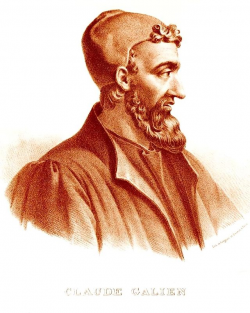Galen

Galen
- Born
- Unknown
Galen was a Greek physician, surgeon and philosopher in the Roman Empire whose influence was felt for many centuries, affecting the development of anatomy, physiology, pathology, pharmacology and neurology as well as philosophy.
He was the originator of using experiments in medical investigations and emphasised the importance of clinical observation, thoroughly examining patients and noting their symptoms. Galen monitored his patients pulse, which remains a standard procedure today.
Galen was personal physician to a number of emperors including Marcus Aurelius and Commodus. At the age of 28 he also became physician to the gladiators of the High Priest of Asia. He claimed he got this position after disembowelling an ape, challenging others to repair the damage and doing it himself when no one else stepped forward. It was in this post that he learnt the importance of diet, fitness, hygiene and preventative medicine, as well as learning how to treat fractures and wounds, which he called ‘windows into the body’. The number of gladiator deaths fell dramatically while Galen was their physician, due to the care he gave them.
Galen’s understanding of anatomy and medicine was influenced by the theory of humorism which was prevalent at the time. This attributed differences in human moods to imbalances in one of four bodily fluids. His ideas dominated Western society for the next 1300 years and medical students studied his writings until the 19th century. It was not until the Renaissance that many of his theories were refuted.
First among doctors and unique among philosophers
Marcus Aurelius, Praen 14: 660
Galen believed that dissection was a key tool for understanding the human body. Roman law did not allow cadavers to be dissected and so Galen worked on both living and dead animals. The animals he used most often were monkeys and pigs, who have anatomical structures that are closer to humans than other animals. He studied both muscle and bone structure.
He was a skilled surgeon and carried out many procedures that would not be used again for centuries. His method of removing cataracts in patients is similar to that used today.
Galen was the first person to recognise the difference between venous (dark) and arterial (bright) blood. His theory of the physiology of the circulation system was accepted until 1628 when William Harvey published the treatise that established how the heart pumped blood around the body.
He conducted many other experiments and investigations which have contributed to our medical knowledge. His nerve ligation experiments supported the theory, that the brain controls motions of the muscles through the cranial and peripheral nervous systems. This is still accepted today. Galen clarified the anatomy of the trachea and was the first person to demonstrate that the larynx generates the voice. He also recognised that urine was produced in the kidney and not in the bladder as had previously been thought.



